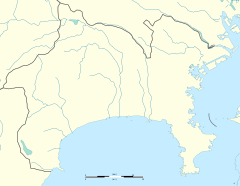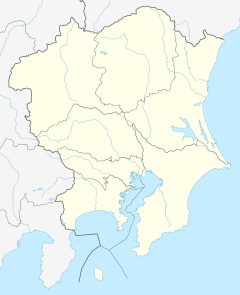Shin-Yokohama Station
This article needs additional citations for verification. (July 2022) |
 The main station building and forecourt in October 2012 | ||||||||||||||||||||||||||||||||||||||||||||||||||||
| Japanese name | ||||||||||||||||||||||||||||||||||||||||||||||||||||
| Shinjitai | 新横浜駅 | |||||||||||||||||||||||||||||||||||||||||||||||||||
| Kyūjitai | 新橫濱驛 | |||||||||||||||||||||||||||||||||||||||||||||||||||
| Hiragana | しんよこはまえき | |||||||||||||||||||||||||||||||||||||||||||||||||||
| General information | ||||||||||||||||||||||||||||||||||||||||||||||||||||
| Location | Shinohara-chō, Kōhoku Ward, Yokohama City, Kanagawa Prefecture Japan | |||||||||||||||||||||||||||||||||||||||||||||||||||
| Operated by | ||||||||||||||||||||||||||||||||||||||||||||||||||||
| Line(s) | ||||||||||||||||||||||||||||||||||||||||||||||||||||
| Connections | ||||||||||||||||||||||||||||||||||||||||||||||||||||
| History | ||||||||||||||||||||||||||||||||||||||||||||||||||||
| Opened | October 1, 1964 | |||||||||||||||||||||||||||||||||||||||||||||||||||
| Passengers | ||||||||||||||||||||||||||||||||||||||||||||||||||||
| JR East, FY2012 | 57,439 daily | |||||||||||||||||||||||||||||||||||||||||||||||||||
| Services | ||||||||||||||||||||||||||||||||||||||||||||||||||||
| ||||||||||||||||||||||||||||||||||||||||||||||||||||
| ||||||||||||||||||||||||||||||||||||||||||||||||||||
| ||||||||||||||||||||||||||||||||||||||||||||||||||||
Shin-Yokohama Station[a] (新横浜駅, Shin-yokohama-eki) is a major interchange railway station in Yokohama, Japan, jointly operated by Central Japan Railway Company (JR Central), East Japan Railway Company (JR East), Yokohama City Transportation Bureau, Sagami Railway (Sotetsu), and Tokyu Railways (Tokyu).
Lines
[edit]Shin-Yokohama Station is served by the Tōkaidō Shinkansen, Yokohama Line, Yokohama Municipal Subway Blue Line, Sōtetsu Shin-yokohama Line, and Tōkyū Shin-yokohama Line.
Station layout
[edit]The JR station consists of an island platform at ground level serving the Yokohama Line, with two elevated island platforms for the shinkansen tracks overhead. The shinkansen platforms 2 and 3 have safety fences, as some trains passed non-stop through the station prior to 2008. The JR Central portion of the station includes a Midori no Madoguchi staffed ticket office. Additionally, the JR East portion of the station includes reserved seat ticket vending machines.
The Municipal Subway, Tōkyū Railways and Sagami Railway (Sōtetsu) share an underground integral concourse, which forms a cross shape. The Municipal Subway owns the northwest to southeast corridor, which provides three separate sets of ticket gates, with the northwest (so-called the "Nissan Stadium ticket gate") and central paid areas providing elevators for barrier-free access to the subway Blue Line platform level which is one story below the underground concourse. The Sōtetsu-Tōkyū parts of the concourse lie directly below and align with the Yokohama Ring Road 2. The northeast concourse is managed by Tōkyū, while the southwest is managed by Sōtetsu. The platform level of Sōtetsu–Tōkyū Link Line is three stories below the integral concourse. Only the southwest concourse managed by Sōtetsu has elevators for the Sōtetsu–Tōkyū platform level. Exits 1 and 5A on the southern side of the concourse are closer to the JR concourse.[1]
JR platforms
[edit]| 1,2 | for Tokyo | |
| 3,4 | for Nagoya, Shin-Osaka, and Hakata | |
| 5 | JH Yokohama Line | for Kikuna, Higashi-Kanagawa,Yokohama, and Ōfuna |
| 6 | JH Yokohama Line | for Machida and Hachiōji |
-
Platforms 1 and 2
-
Platforms 3 and 4
-
Platforms 5 and 6
-
View of the Shinkansen platforms from the eastern end of platforms 3 and 4 in February 2011
-
The Yokohama Line platforms, August 2008
Yokohama Municipal Subway platforms
[edit]| 1 | for Yokohama, Kannai, Kami-Ōoka, Totsuka, and Shōnandai | |
| 2 | for Azamino |
-
Ticket gates
-
Platform
Sōtetsu–Tōkyū Link Line platforms
[edit]| 1,2 | for Hazawa yokohama-kokudai and Nishiya, through service for Futamata-gawa, Yamato, Ebina and Shōnandai | |
| 3,4 | SH Tōkyū Shin-yokohama Line | for Shin-tsunashima and Hiyoshi, through service for Shibuya, Ikebukuro, Meguro, Akabane-iwabuchi, Urawa-misono, Nishi-takashimadaira, etc. |
Platforms 2 and 3 share the same track which is primarily for southbound trains which terminate at this station or emergency docking. On weekdays only, 1 midnight train departs from platform no.1 for Musashi-Kosugi.[2]
History
[edit]
Real estate agents purchased the private property in the area by telling residents and local government officials that the land was needed to build a Nissan/Ford motor vehicle factory which would provide increased employment. Actually, however, the agents were in league with JNR and national politicians from the LDP party to acquire the land for the proposed station, which was not disclosed to the public at this time. The subterfuge was subsequently exposed in a novel and popular film called Kuro no Chō Tokkyū (黒の超特急, lit. The Black Super Express). The police opened several investigations, but the suspected agents, JNR employees, and political staffers fled the country until the statute of limitations on the alleged crimes expired.[3]
Shin-Yokohama Station opened on 1 October 1964, with the opening of the Tokaido Shinkansen.[4] At the time, the surrounding area was completely rural, and the site was selected as it was the intersection of the Tōkaidō Shinkansen tracks with the existing Yokohama Line. The station was connected to the Yokohama Municipal Subway system on 14 March 1985.[5] With the privatization of JNR on 1 April 1987, the JNR portion of the station came under the operational control of JR East. The station building was remodeled in 1998.[citation needed]
Station numbering was introduced to the Yokohama Line platforms 20 August 2016 with Shin-Yokohama being assigned station number JH16.[6][7]
Sōtetsu–Tōkyū Link Line
[edit]The Sōtetsu–Tōkyū jointly operated Shin-yokohama Station opened on 18 March 2023[8] is one of the major infrastructures of the Eastern Kanagawa Rail Link project to improve the regional access to the Shin-Yokohama Shinkansen station by rail, which was previously only accessible via the JR Yokohama Line and Municipal Subway Blue Line. As a response to the new railways, JR Tokai started a new limited Nozomi service departs from Shin-Yokohama for Nagoya and Shin-Ōsaka on the same day as the opening of the Sōtetsu–Tōkyū Link Line.[9]
Because the Sōtetsu–Tōkyū platform level is directly 2-story underneath the Municipal Subway Blue Line platform, the subway platforms were underpinned to fortify the foundation. The operation of the subway Blue Line was not obstructed during the construction of the new station. All the involved construction parties were commended by the Japan Society of Civil Engineers in 2020 for commencing such a difficult task.[10]
-
View above the construction site
Passenger statistics
[edit]In fiscal 2012, the JR East station was used by an average of 57,439 passengers daily (boarding passengers only).[11] The JR East passenger figures for previous years are as shown below.
| Fiscal year | Daily average |
|---|---|
| 2000 | 44,226[12] |
| 2005 | 48,040[13] |
| 2010 | 56,415[14] |
| 2011 | 56,666[15] |
| 2012 | 57,439[11] |
Surrounding area
[edit]The Nissan Stadium (formerly International Stadium Yokohama), the largest stadium in Japan with a capacity of 72,327 seats, was host to the 2002 FIFA World Cup final match and is the home of the Yokohama F Marinos soccer team. The Nissan Stadium, Yokohama Arena, and Yokohama Rosai Hospital are each about a 10-minute walk from the station. The Shin-Yokohama Raumen Museum is about a 5-minute walk from the station.
Nearby hotels
[edit]- Shin Yokohama Prince Hotel
- Hotel Associa Shin-Yokohama
Notes
[edit]- ^ JR capitalizes the "y" in "Shin-Yokohama"; the rest of the rail operators decapitalize the "y" and spell it as "Shin-yokohama".
References
[edit]- ^ 市営地下鉄ブルーライン新横浜駅の新しい改札口をオープンします! (pdf) (in Japanese), Construction Division, Transport Bureau, Yokohama Municipal Government, 16 December 2022, retrieved 10 March 2023
- ^ Train Departures of Tōkyū Shin-yokohama Line (PDF) (in Japanese), Tōkyū Railways, retrieved 10 March 2023
- ^ Whiting, Robert, "Negative impact of 1964 Olympics profound", Japan Times, 24 October 2014, p. 14
- ^ 日本国有鉄道停車場一覧 [JNR Station Directory]. Japan: Japanese National Railways. 1985. p. 24. ISBN 4-533-00503-9.
- ^ Terada, Hirokazu (19 January 2013). データブック日本の私鉄 [Databook: Japan's Private Railways]. Japan: Neko Publishing. p. 235. ISBN 978-4-7770-1336-4.
- ^ "⾸都圏エリアへ 「駅ナンバリング」を導⼊します" [Introduce “station numbering” to the Tokyo metropolitan area] (PDF). jreast.co.jp (in Japanese). 6 April 2016. Archived from the original (PDF) on 7 December 2022. Retrieved 7 January 2023.
- ^ Kusamachi, Yoshikazu (7 April 2016). "JA・JK・JT・AKB…JR東日本、首都圏で駅ナンバリングなど導入へ" [JA, JK, JT, AKB … JR East to introduce station numbering in the Tokyo metropolitan area]. Response Automotive Media (in Japanese). Archived from the original on 6 August 2022. Retrieved 7 January 2023.
- ^ "New railway link shortens ride from Kanagawa into Tokyo - The Asahi Shimbun: Breaking News, Japan News and Analysis". The Asahi Shimbun. 18 March 2023. Retrieved 18 March 2023.
- ^ "Shin-Yokohama new departure point for Tokaido Shinkansen Line", The Asahi Shimbun, 13 February 2023, retrieved 22 March 2023
- ^ 新横浜駅前の地下に作った相鉄・東急直通線「新駅」、難工事に土木学会賞, Shin Yokohama Shimbun (in Japanese), 22 July 2020, retrieved 2 March 2023
- ^ a b 各駅の乗車人員 (2012年度) [Station passenger figures (Fiscal 2012)] (in Japanese). Japan: East Japan Railway Company. Retrieved 2 November 2013.
- ^ 各駅の乗車人員 (2000年度) [Station passenger figures (Fiscal 2000)] (in Japanese). Japan: East Japan Railway Company. Retrieved 2 November 2013.
- ^ 各駅の乗車人員 (2005年度) [Station passenger figures (Fiscal 2005)] (in Japanese). Japan: East Japan Railway Company. Retrieved 2 November 2013.
- ^ 各駅の乗車人員 (2010年度) [Station passenger figures (Fiscal 2010)] (in Japanese). Japan: East Japan Railway Company. Retrieved 2 November 2013.
- ^ 各駅の乗車人員 (2011年度) [Station passenger figures (Fiscal 2011)] (in Japanese). Japan: East Japan Railway Company. Retrieved 2 November 2013.
External links
[edit]- Shin-Yokohama station information (JR Central) (in Japanese)
- Shin-Yokohama station information (JR East) (in Japanese)
- Shin-Yokohama station information (Yokohama Subway) (in Japanese)
- Shin-Yokohama station information (Tokyu Railways) (in Japanese)
- Shin-Yokohama station information (Sotetsu Group) (in Japanese)














